FC Barcelona Femeni are currently dominating the Primera Division de La Liga de Futbol Femenino competition, leading second-place Club Atletico de Madrid Femenino by nine points. They have accumulated 59 points from a potential total of 63, with 19 wins and two ties from the 21 matches played. Barcelona have a +80 goal differential yet are aiming for their first title since the 2014/15 season after finishing runner-up to Atletico for the past three seasons and Athletic Club Femenino (Bilbao) before that.
Barcelona attempt to dominate possession of the ball and have the league’s highest average possession (67.3%), the highest average number of passes per 90 (622.37), the highest % pass completion rate (86%), the highest possession average duration (20.5 seconds) and the highest number of passes to the final third (86.88).
This tactical analysis will focus on the attacking structures, system and tactics utilized by Barcelona in order to break down a compact defensive shape. Focus will be given to analyzing the roles and responsibilities of each player in possession, the creation of time and space, the movement to unbalance the oppositions defensive structures and the generation of superiorities.
Barcelona implement structured positional play tactics with the aim of generating superiorities during the attack, in order to progress the ball through the thirds towards the opponent’s goal. These superiorities are numerical, positional and qualitative.
What are superiorities?
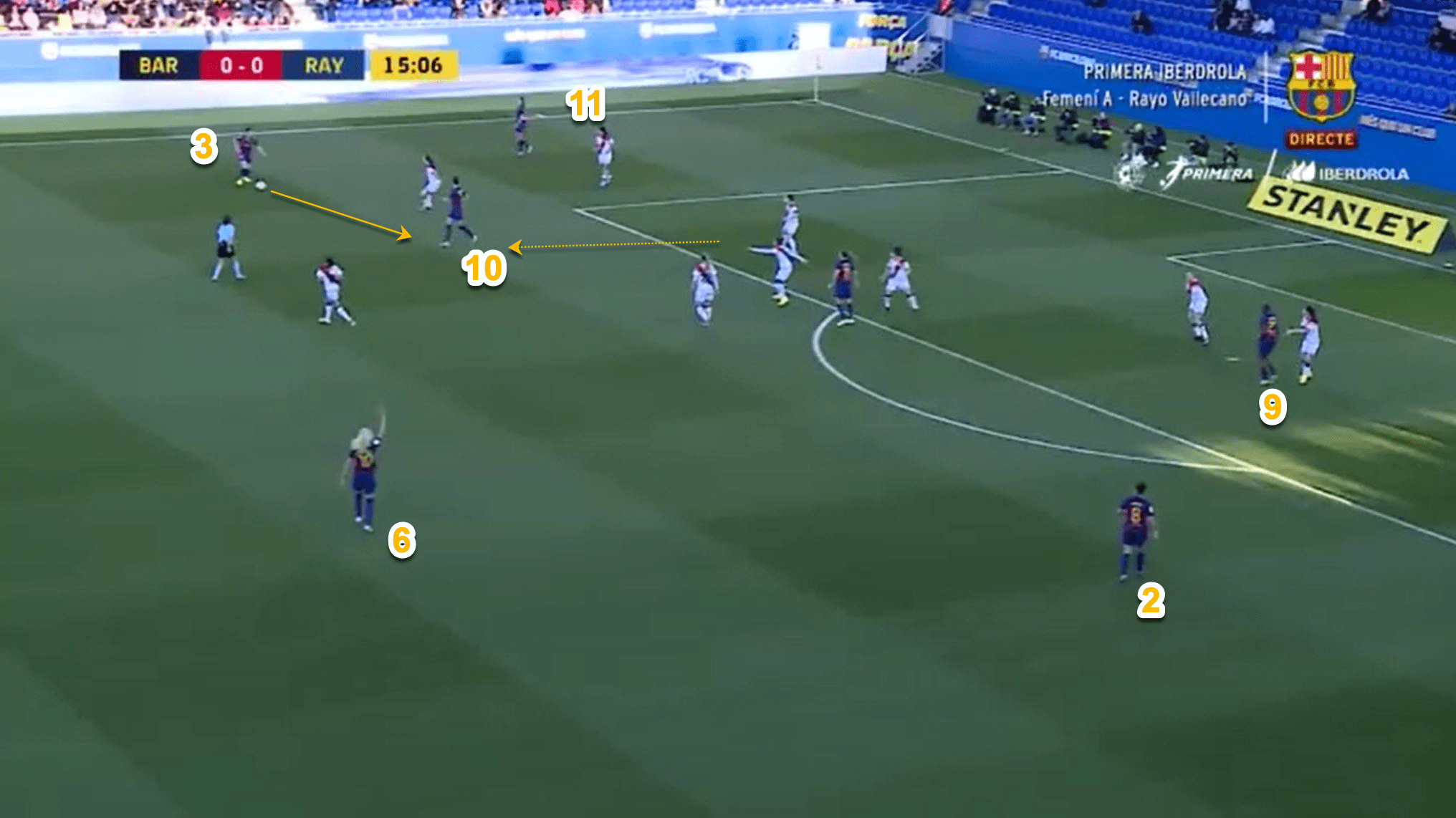
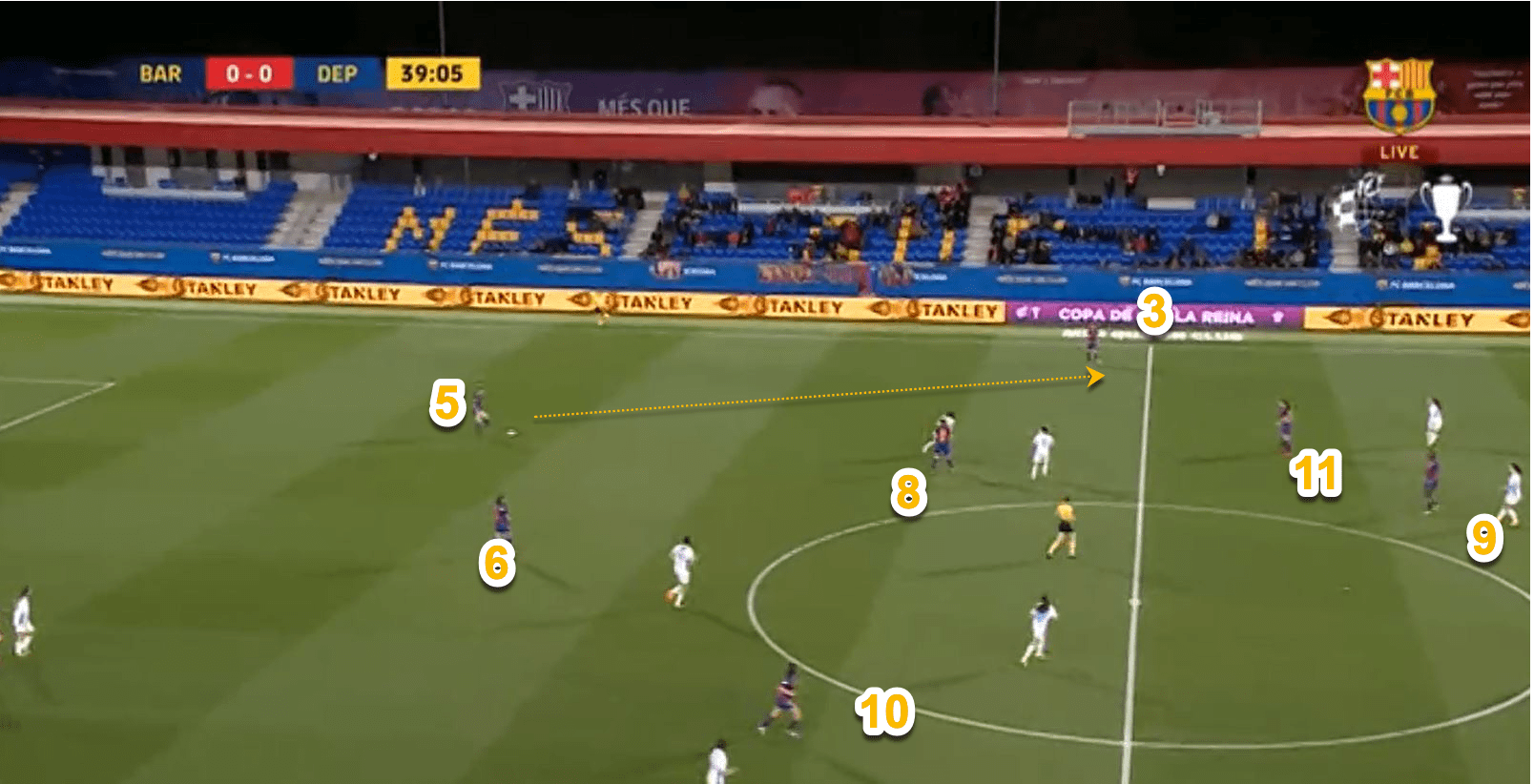
Positional Superiority is a term that also refers to having players in a position to be able to receive the ball facing forward with time and space. Specifically, being able to receive the ball in between or behind the opposition’s lines of pressure through positioning.
In the above example, the central defender of Barcelona, #5 Mapi Leon, is in possession facing forward and unopposed. As the opposition right forward is infield (interior channel) the passing line is open wide and into #3 Leila Ouahabi. The right forward of Real Club Deportivo de La Coruna Femenino cannot defend both the vertical pass into #11 Martens and #3 Ouahabi. As a result, Ouahabi has positioned herself in such a way that she can receive the ball behind the oppositions (right forward) front line of pressure and create a new 2v1 situation by running with the ball forward.
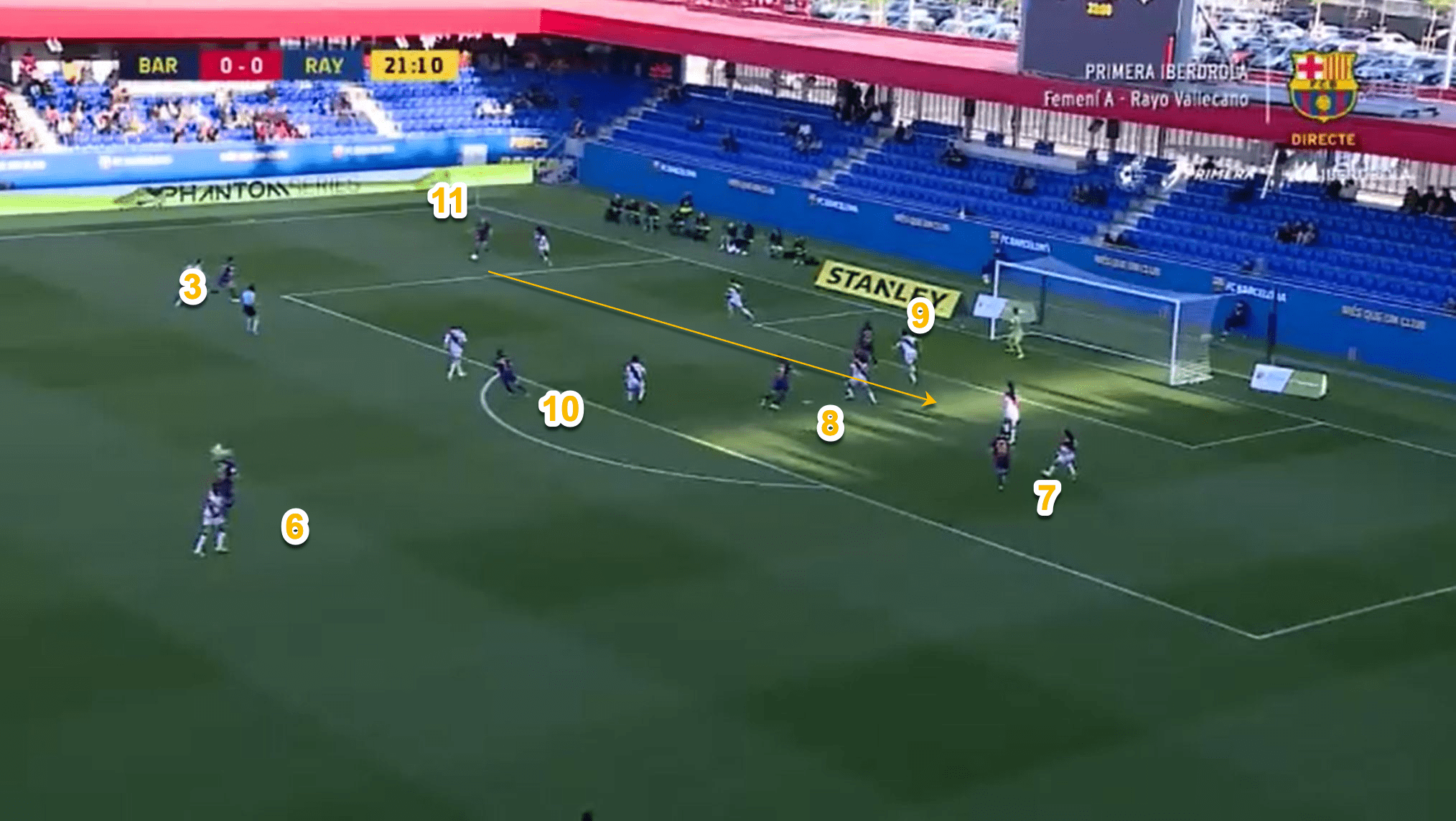
The above diagram is an example of qualitative superiority. This describes a situation in which Barcelona have been able to find one of their better attacking players, in this case #11 Lieke Martens, in possession, facing forward and able to run with the ball at a weaker opponent. Here Martens was able to attack the right defender of Rayo 1v1 in order to create a crossing opportunity.
Opposition defensive organization and compactness
Organized defending strategies can be divided into three ‘blocks’. These ‘blocks’ refer to the position of the line of confrontation and where the defending team will attempt to pressure the opposition. This is not during a transitional phase but when the team without possession have enough time to organize into a specific structure.
A low ‘block’ refers to a compact defensive shape and lower line of confrontation, here the out of possession team focus on defending the penalty area and attempt to deny time and space to attack into this zone. This tactical approach has two specific potential benefits, to deny the space behind the last line of pressure whilst encouraging the opponent to build up attacking play and structures that position players in higher zones of the field, thus potentially creating opportunities for counter attacking. The result of this strategy is that attacking teams can be forced to cross the ball from the extreme wide zones of the field, shoot from long distance or to attempt passes between lines that have minimal space.
A team that defends with a ‘high’ block will be more aggressive in attempting to win possession of the ball. Here the defensive line is set higher and towards the opponent’s goal, this does leave space behind for vertical/more direct passing. Teams implementing a ‘high’ block will apply pressure from the forwards through the team and attempt to regain the ball through a challenge or by directly forcing the opponent into a mistake. This is also a tactic that impacts positive transitional moments (when team wins possession of the ball) as they will be closer to the opponent’s goal.
A ‘medium’ block is a balance of the two previous defensive strategies. This tactical approach attempts to limit space behind the last line of pressure (defenders) and not allow the opponent to easily build up attacking structures close to the goal being defended. The line of confrontation within a medium block is close to the halfway line.
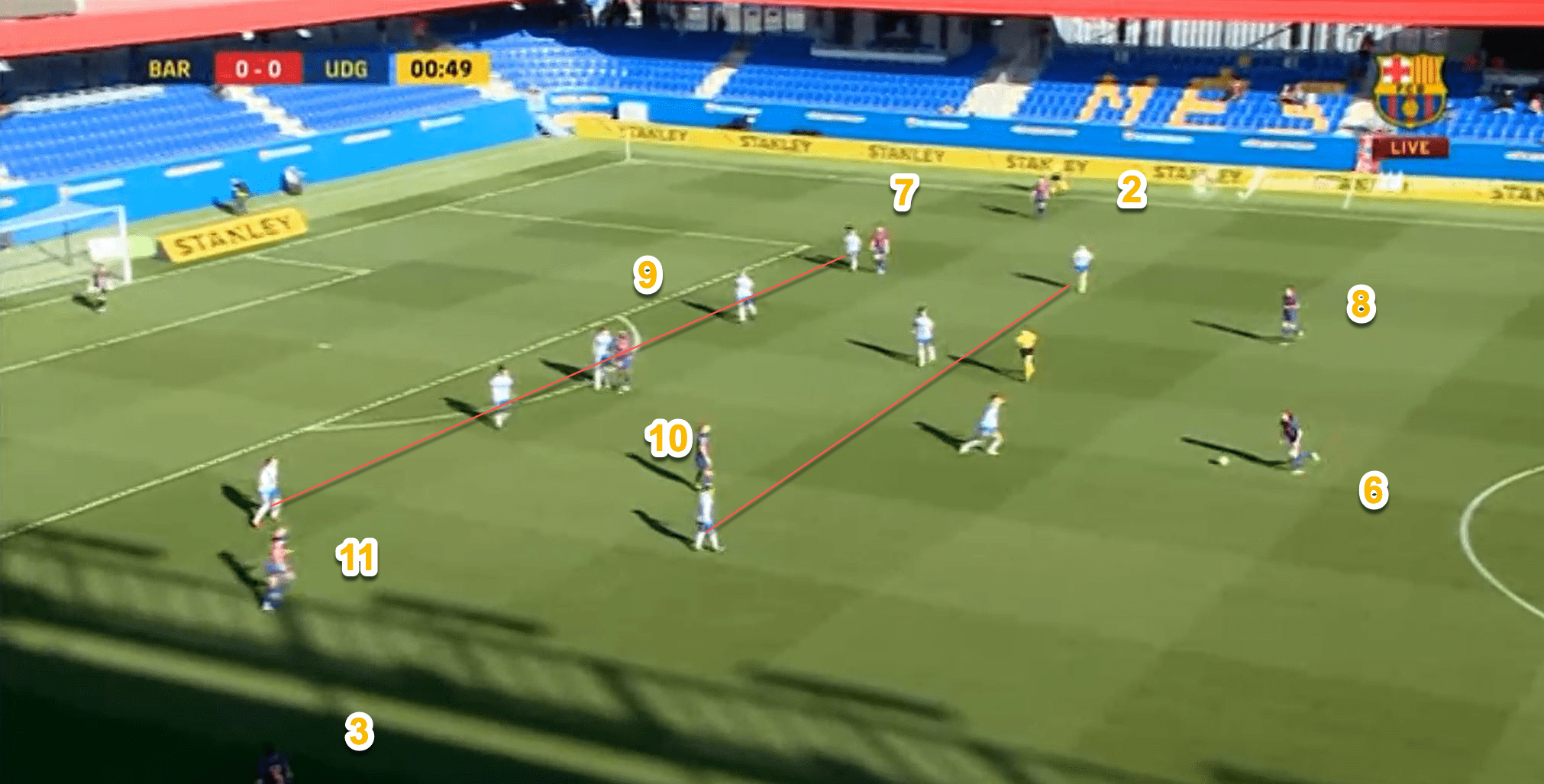
Due to imbalances in the team’s ability, a scout report will identify that most of the opponents Barcelona face focus on defensive organization and moving players behind the ball and between this and the goal being defended. Teams attempt to limit the space Barcelona have to attack by forming into compact lines both vertically and horizontally. Compactness refers to a defensive organization that can not only limit passing lines and opportunity to dribble through/around but also creates multiple pressing potential players due to the short distances between players around the ball. This article specifically analyzes how Barcelona attack against organized and compact defensive structures that are in a low or medium block.
In the above example, UD Grandilla Tenerife have formed a 1-5-4-1 defensive structure. The #9 (central forward) has remained high to offer counter attacking opportunities and to attempt to deny the central defenders of Barcelona time and space in possession. However, the remaining ten players have formed a low block, defending the edge of the penalty area. This is a defensive organization structure that is a pattern Barcelona face consistently and has been formed from only 49 seconds into the beginning of the game.
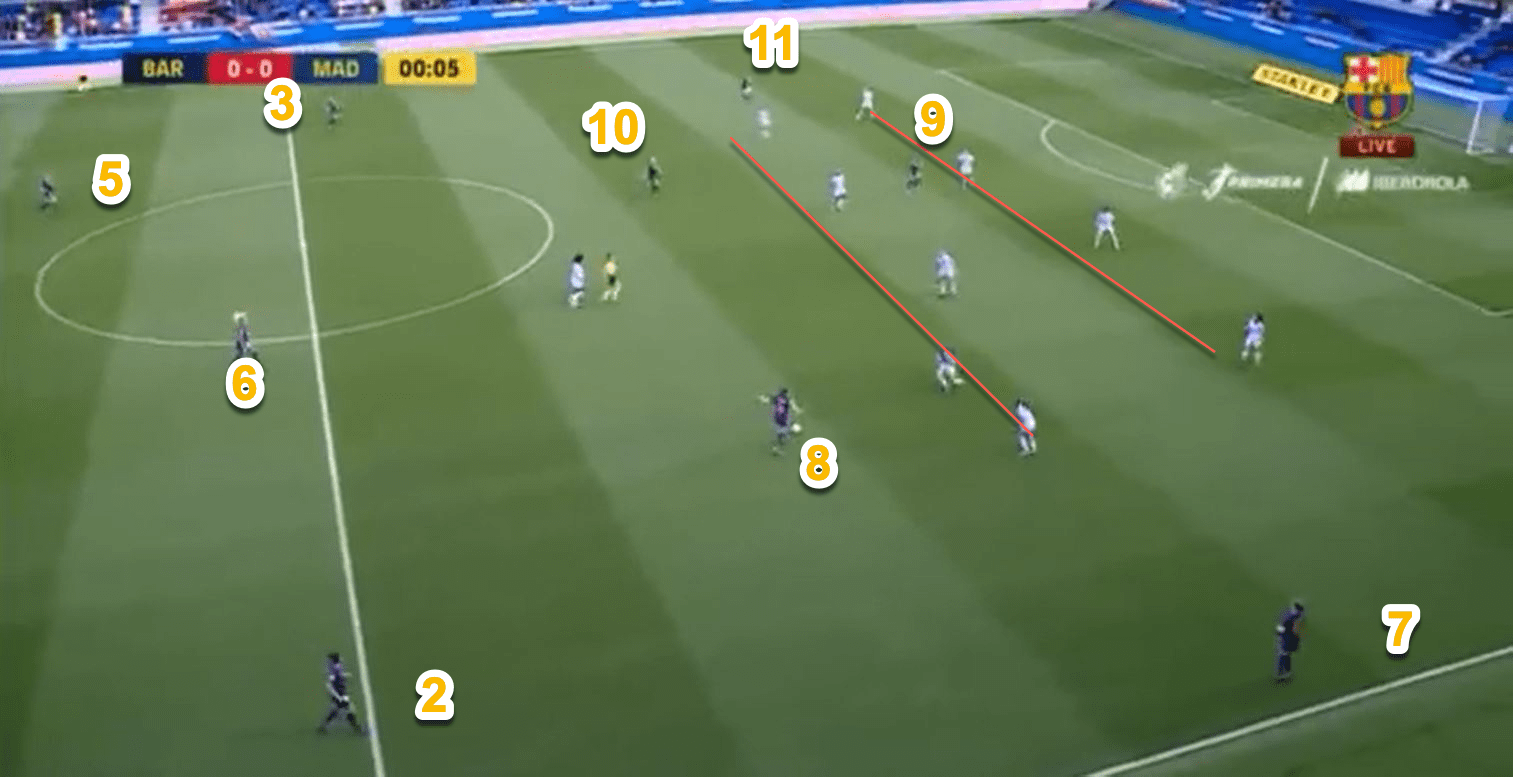
The above diagram is another good example of the opposition defensive organization Barcelona face when attacking. On this occasion, only 5 seconds into the game, Madrid CFF have dropped into a low and compact defensive structure and a 1-4-5-1 tactical shape. Here Madrid CFF are limiting the space centrally for Barcelona to play through and encouraging the ball to be played into the wide zones of the field.
Spreading the opposition, maximizing width, depth and height
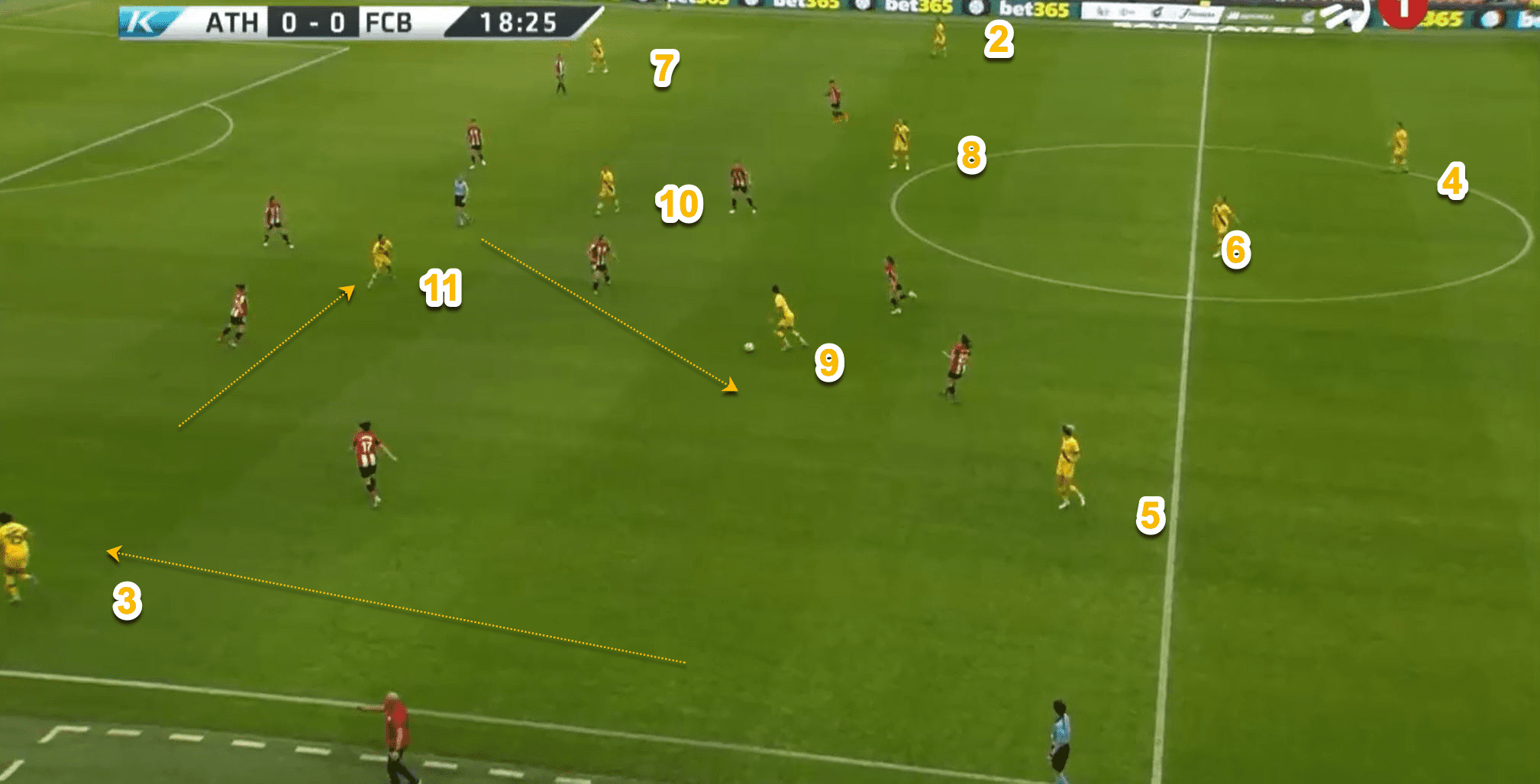
The first stage for Barcelona to attack against organized opposition is to progress the ball into the opponent’s half and organize into an expansive and attacking shape. From the diagram above of Barcelona Vs. Bilbao, Barcelona demonstrate width to stretch the opponent horizontally provided by the #2 and #3, height to stretch the opposition vertically provided by the #7 and #3, depth provided by #5, #4 and #6 and support around the player in possession of the ball (#9) provided by #8, #11 and #10. By initially stretching the field as wide and high as possible, Barcelona can then create opportunities to unbalance the opposition and move them from a compact defensive shape.
In the specific example above, by rotating the #9 (Hermoso) into midfield and the #11 (Caldentey) into the central channel, space has created space for #3 (Ouahabi) to attack into wide and high on the left side of the field.
Wide combinations – Underlapping runs
The following diagrams are situations in which Barcelona have been able to find a wide player in possession of the ball facing forward. The closest player has made an underlapping run. This is a situation which describes running inside the player in possession of the ball and behind the opposition defender, typically when the player in possession is in the outside channel.
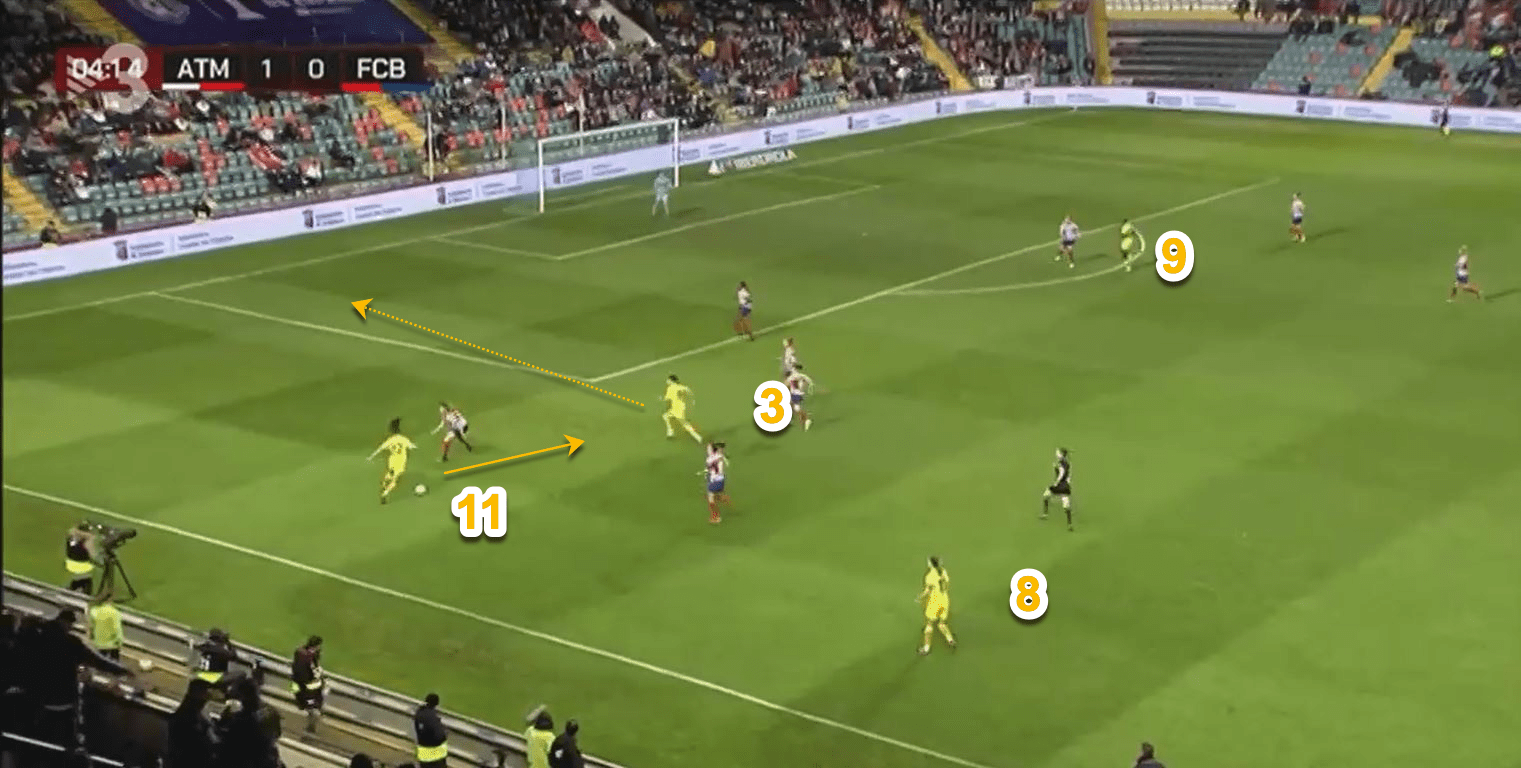
In this specific example vs. Atletico, #11 Martens has received possession and is facing the left defender of Atletico. #3 Serrano, as the closest player, makes an underlapping run behind the wide defender with #8 Alexia Putellas supporting underneath. Martens has three options in this situation, a) find the runner in behind the opponent, b) cut inside and attack on the dribble or c) find the deeper support passing option in order to a) change the angle of attack or b) cross from deeper position. In this specific situation, due to the right defender of Atletico overcommitting positionally to deny space behind and the two central players also dropping with Serrano, Martens cuts inside on the dribble into the central zone and shoots on goal.
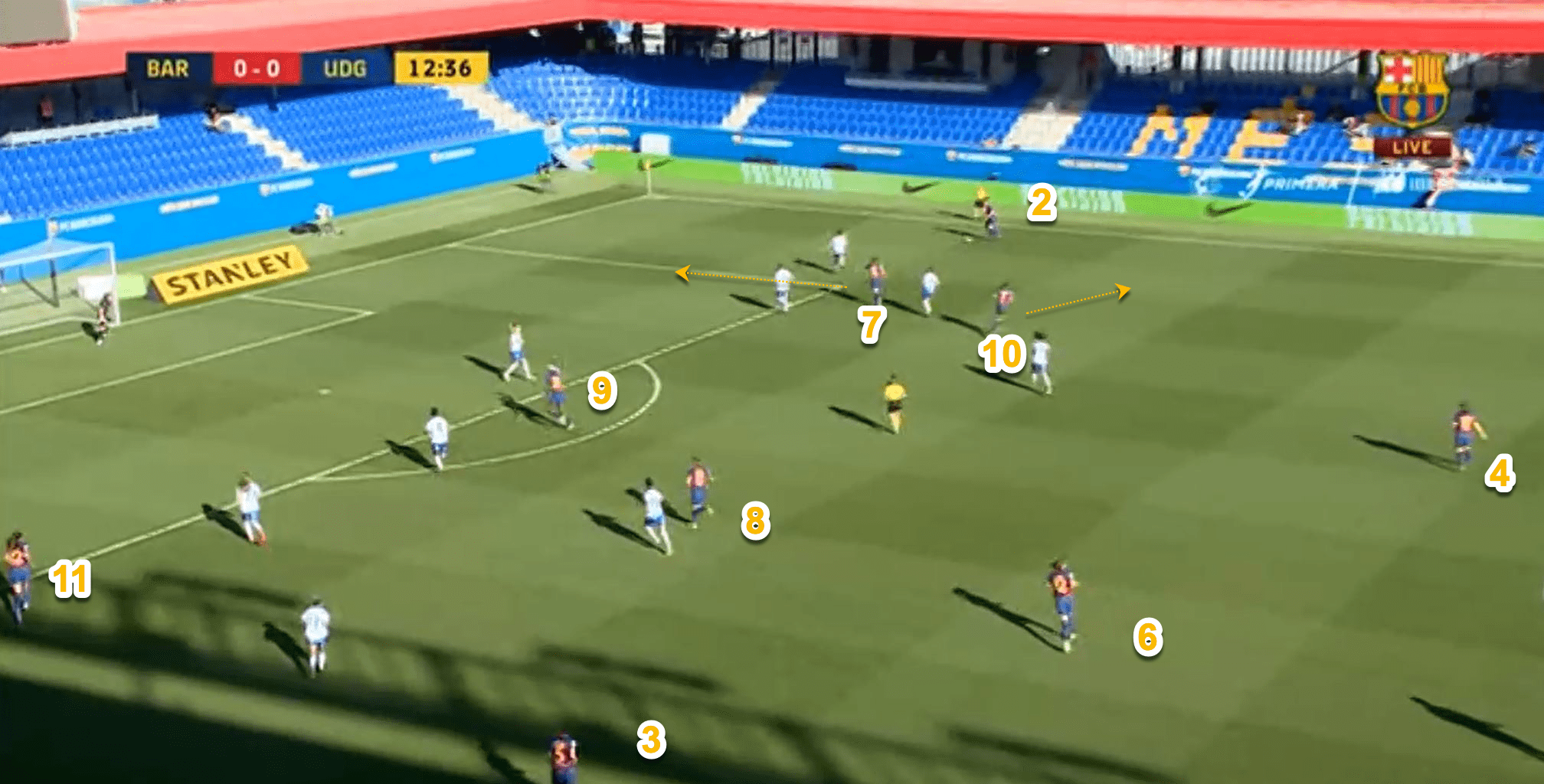
Here Barcelona #2 Marta Torrejon is in possession in the wide right channel, the closest player #7 Caroline Graham Hansen makes the underlapping run behind the oppositions wide defender with #10 Jennifer Hermoso supporting underneath. In this specific example the space behind is limited and the defenders of UD Grandilla Tenerife drop further with the underlapping player. With no numerical, positional or qualitative superiorities available, #2Torrejon has the option of changing the angle of attack through #10 Hermoso but instead chooses a low percentage cross from the extreme wide zone which is ultimately cleared by the opponent.
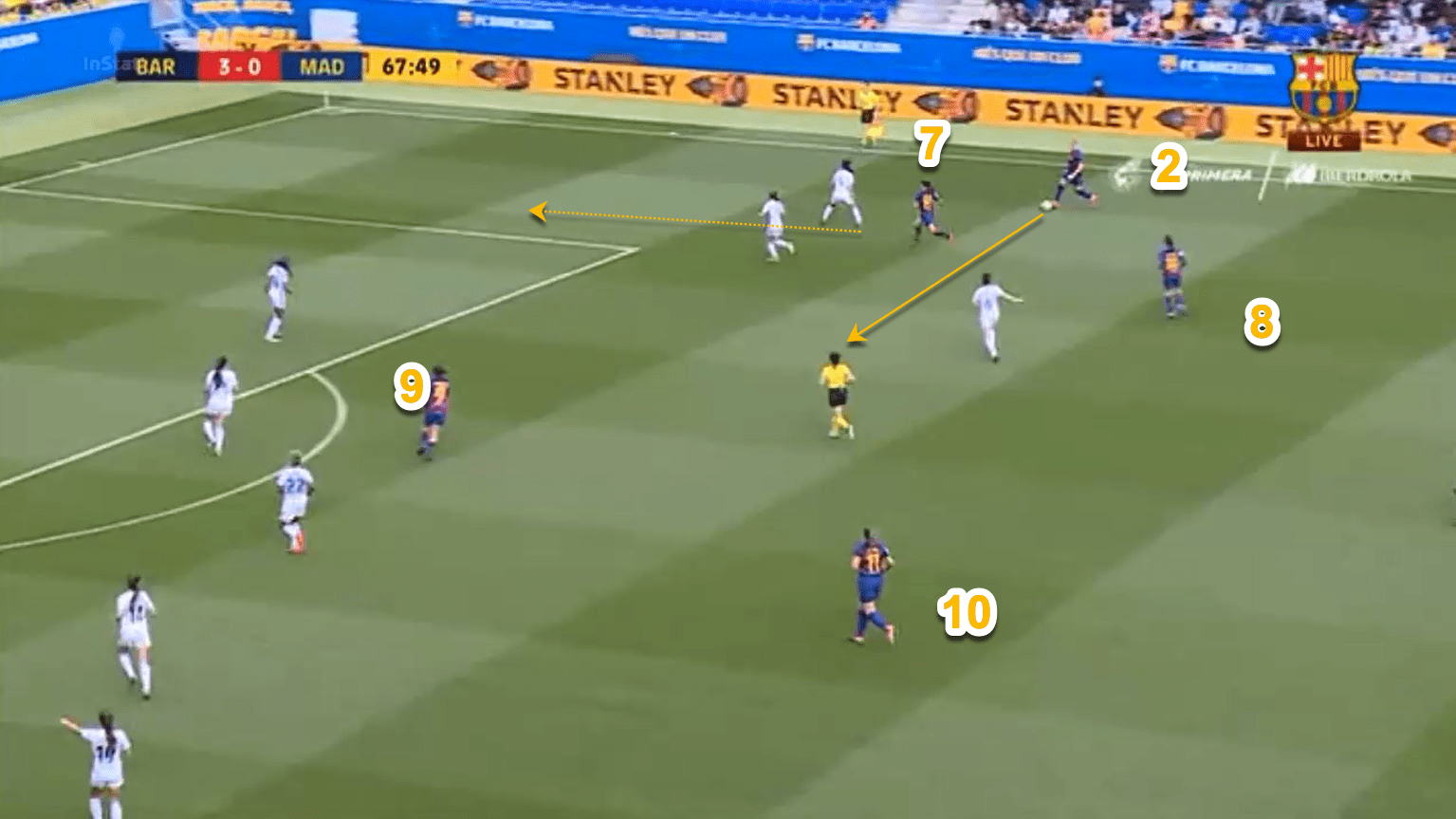
The above example of an underlapping run has the #7 Hansen moving behind the Madrid CFF defenders. The result of this underlapping run generates space centrally for the player in possession to attack on the dribble.

This final example of a situation in which Barcelona implement an underlapping run is an example in which the underlapping player is found with a pass, running behind the opponent into space. Here, #7 Hansen has received possession in the right outside channel and is facing forward, #2 Torrejon recognizes the space to run behind the opponent and makes the underlapping run. As #7 Hansen times the pass effectively and has provoked the opponent to press, #2 Torrejón is able to receive behind the line of pressure with a crossing opportunity from the interior channel.
Wide combinations – Overlapping runs
An overlap combination is a situation which is similar to the underlapping combinations described previously. However, during an overlap the player supporting the player in possession makes a run on the outside to exploit space in this area. This type of run is implemented if the player in possession takes their first touch infield.
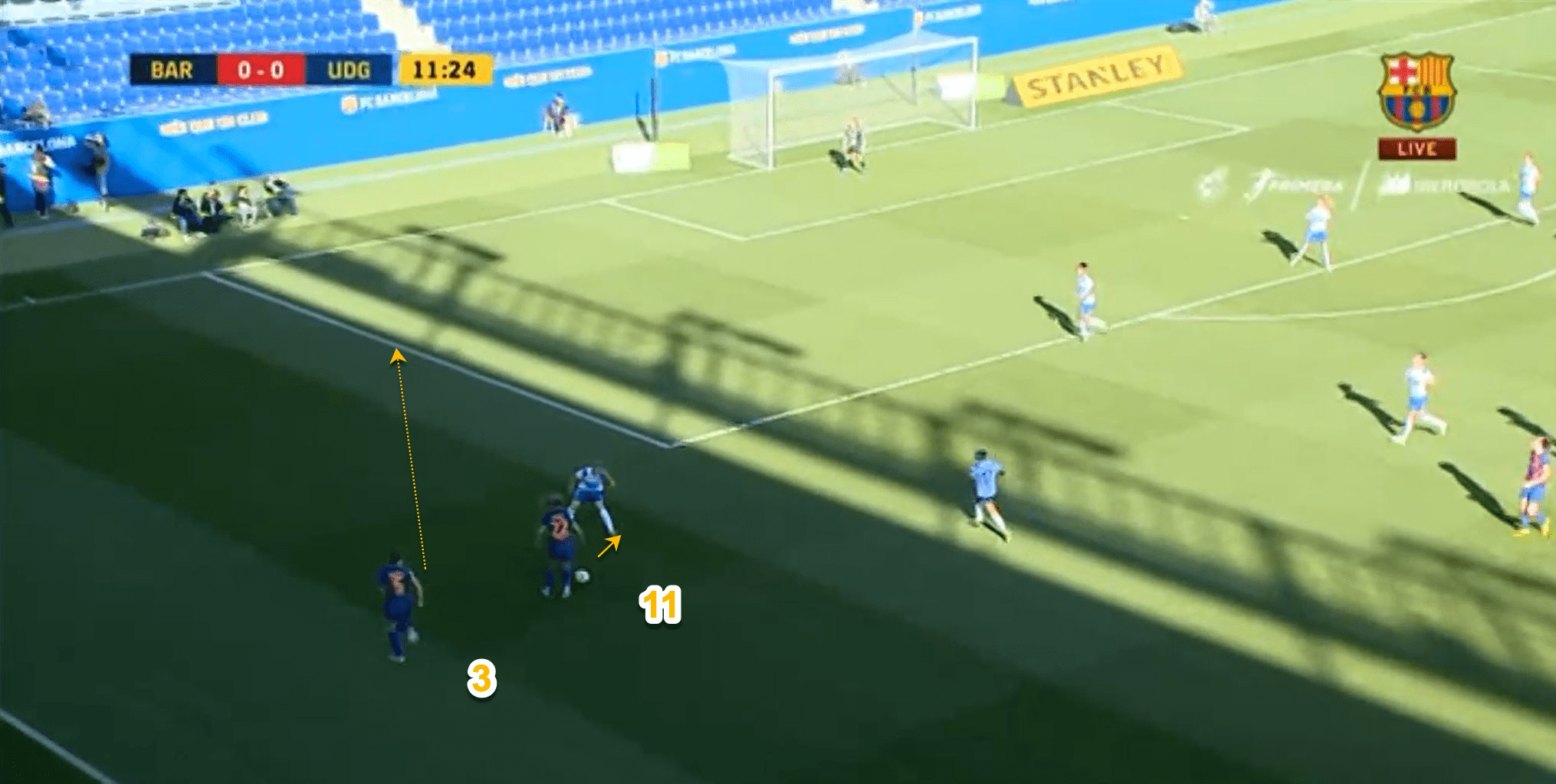
The above overlap combination example is another wide combination situation and specifically a 2v1 numerical superiority situation. Barcelona have been able to find #11 Martens in possession, facing forward. Here, as she is in the interior channel and cuts inside on her first touch, #3 Serrano makes the overlapping run into space that is wide and behind the opponent. Martens commits the defender to pressure before timing the pass behind, resulting in Serrano being able to cross the ball into the penalty area.
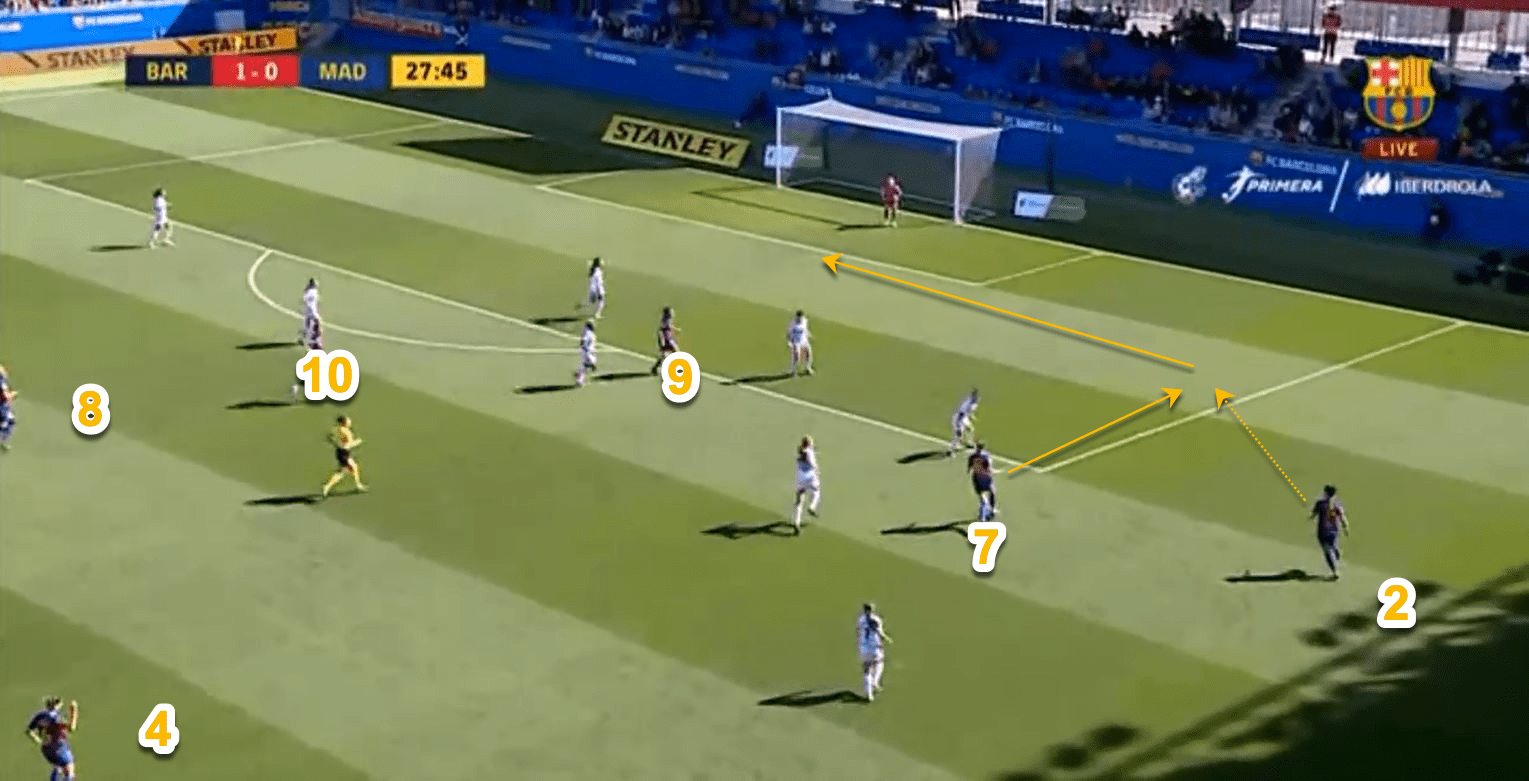
A second example of Barcelona attacking in wide areas and implementing an overlapping run is shown above. Here #7 Hansen was able to receive a pass into the interior channel which eliminated the forward and midfield defensive lines of Madrid CFF. As she dribbled infield, Hansen did so directly at the wide defender in order to ‘fix’ the opponent. This created space for the overlapping #2 Torrejon to support outside and ahead of the ball. In this specific example, as the left defender overcommitted to defend the space for the overlapping player, Hansen was able to further continue her run infield and attack the goal individually.
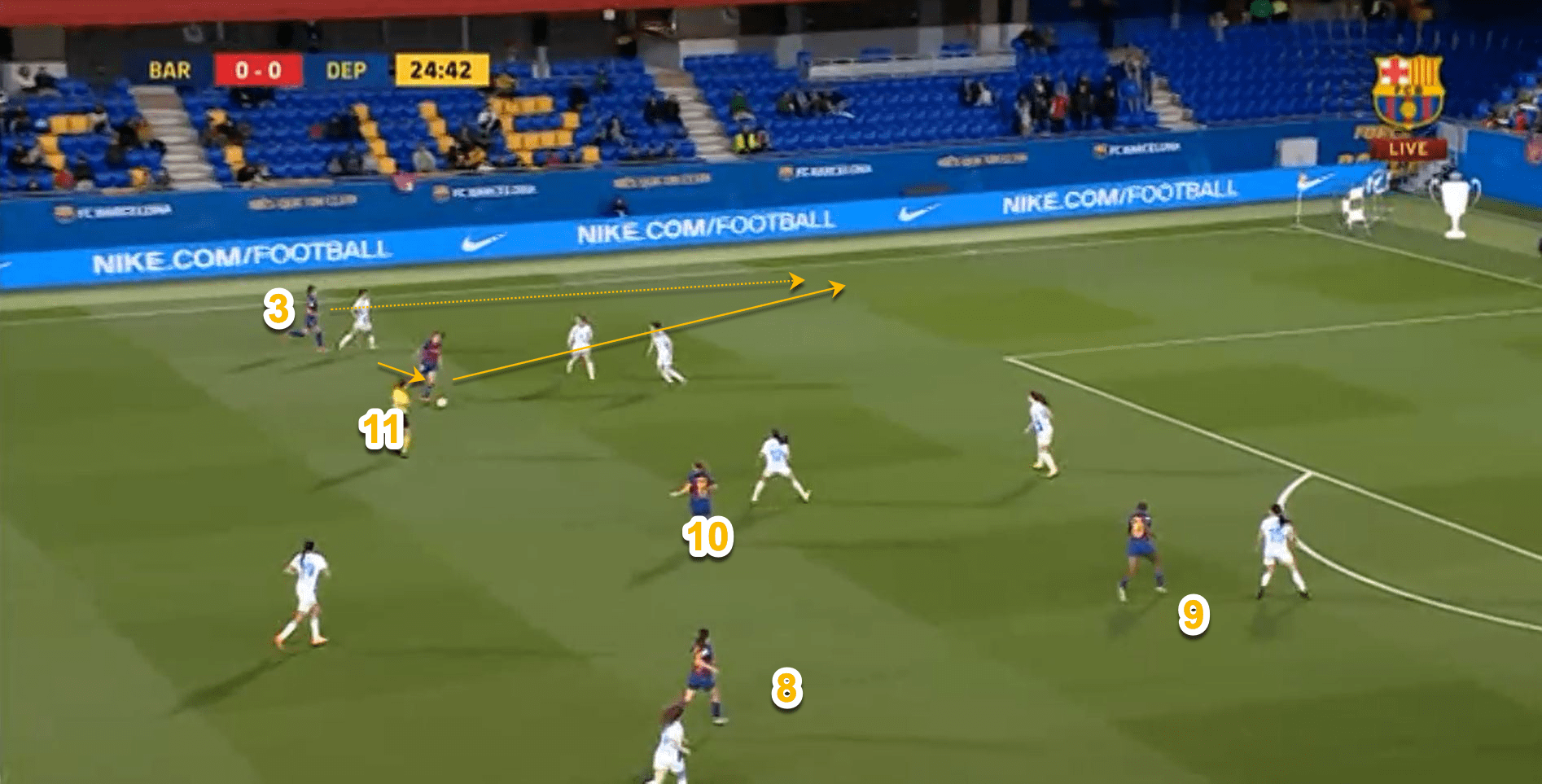
The final example of a wide combination overlapping run is from Barcelona vs. Real Club Deportivo de La Coruna. In this specific situation, #3 Leila Ouahabi has found a vertical pass into #11 Martens who was positioned in the outside channel. As Martens drove infield on her first touch this was the cue for #3 Ouahabi to overlap and move into the space created. With two opposition defenders committed to pressing Martens inside, Ouahabi gains space on her direct opponent and can receive the ball facing forward in an attacking and potential crossing zone.
Positioning between the lines (interior channel)
Finding space within a compact defensive shape is difficult, by the very nature of this tactical defensive approach, the spaces between defensive players is small. When the opponent has limited the space behind the last (defensive) line of pressure, Barcelona use specific player movements to overload the central zone and attempt to receive the ball behind the midfield line of pressure.
This player can either a) receive the ball unopposed and move forward or b) if they have been marked/pressured, utilize the space created. Barcelona structurally move the ball to move the opponent. The following section will describe scenarios in which Barcelona a) receive the ball in the interior space between the opponent’s defensive lines or b) are able to exploit the space behind due to movement out of compact shape from the opponent.
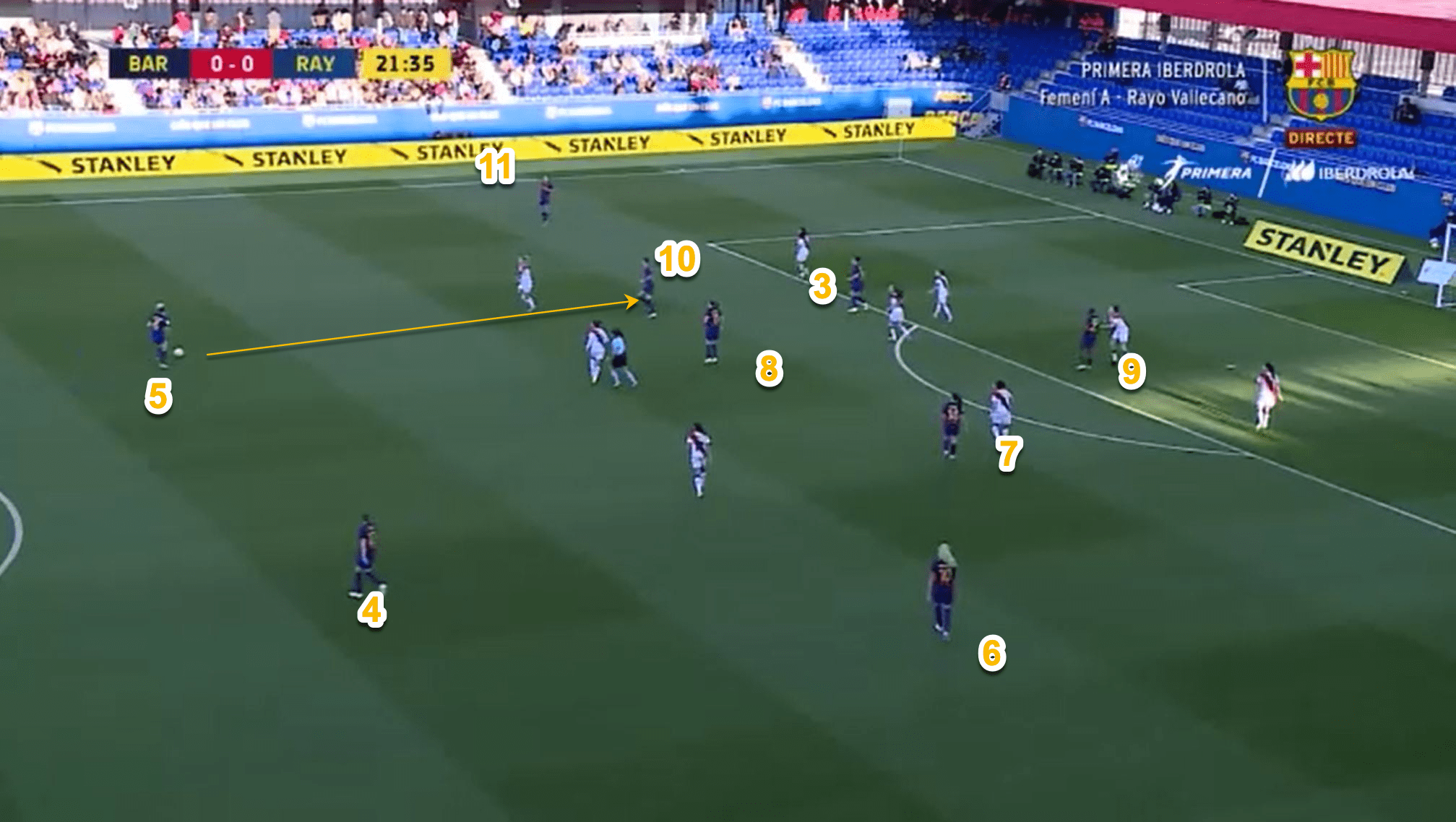
In the example above, two distinct defensive lines are observed within the defensive structure of Rayo. #10 Hermoso has positioned herself in between these two horizontal lines and between the vertical lines of two Rayo defenders. By moving into this ‘box’, Hermoso can receive the ball and combine towards goal or wider with #11 Martens. If Hermoso was marked tightly by the right defender (who would have to move forward) then space for a more vertical and direct pass from #5 Mapi Leon into #11 Martens would be available. If the right forward of Rayo had moved centrally to deny the space for Hermoso to receive this pass, #5 Mapi Leon would have a simple wider option directly into Martens. By moving into this zone, Hermoso has created many problems for Rayo who cannot defend both inside/outside &/or deeper and between the lines.
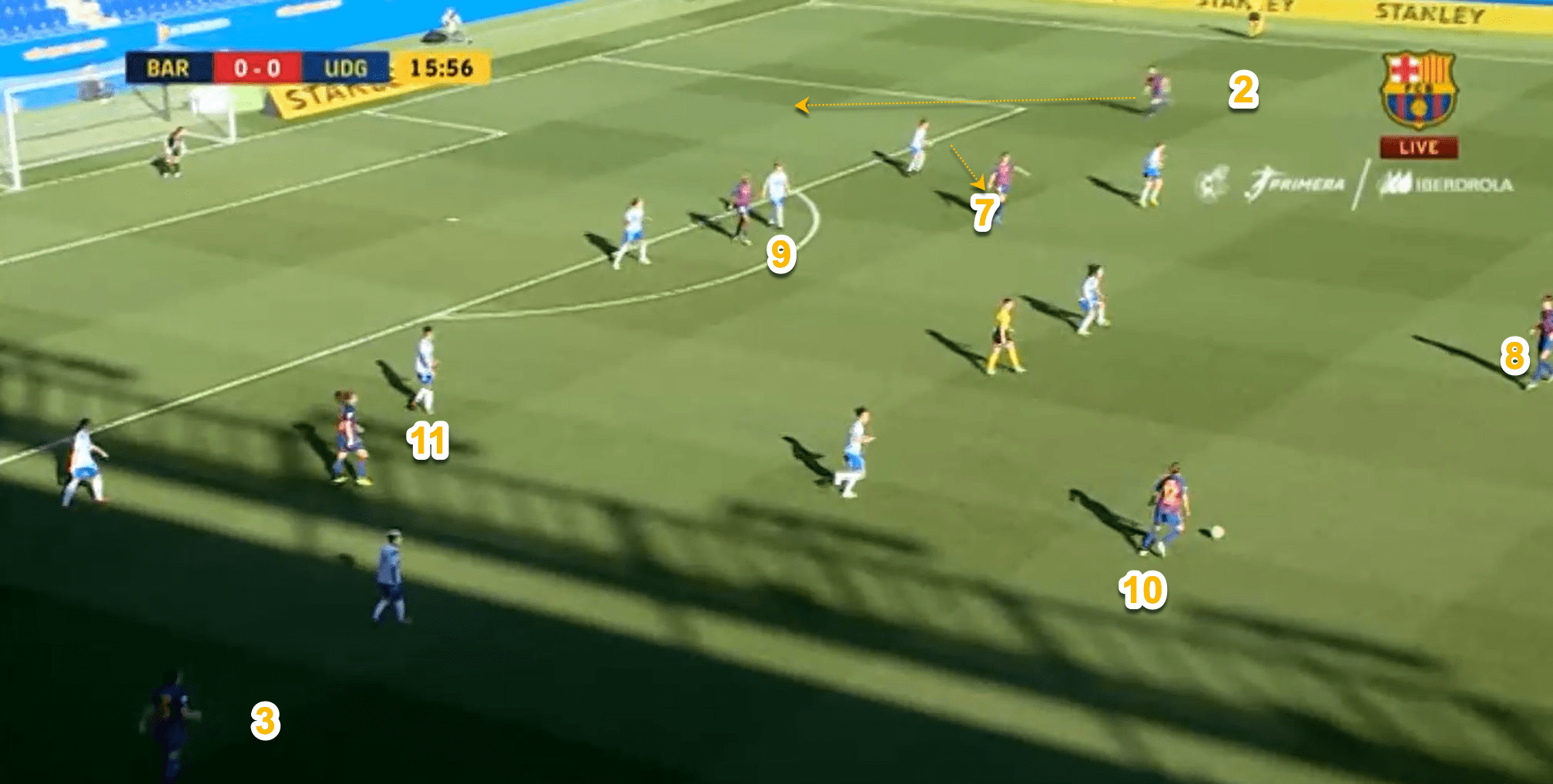
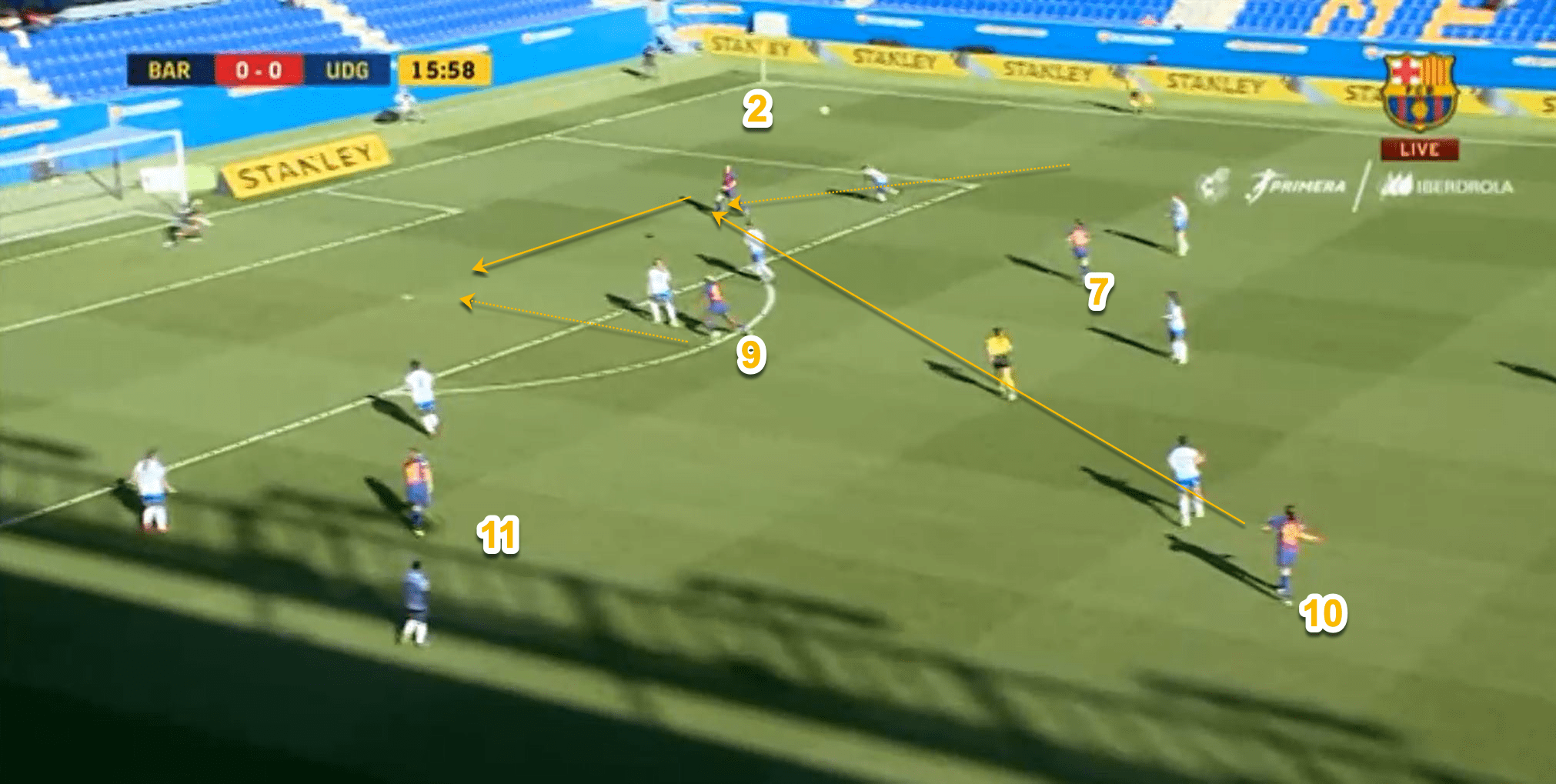
The previous two diagrams show an example where the #7 right forward (in this example Hansen) has moved into the interior channel. This fixed the defender both central and with an emphasis on moving forward to pressure this space. Unlike the previous example vs. Rayo where the defender limited the space behind, here the wide left defender of UD Grandilla Tenerife has not defended the deeper space. Barcelona have recognized this and have been able to exploit by playing a diagonal pass into the #2 right defender Torrejon behind the last line of pressure. The result was a cross into #9 Oshoala and subsequent easy finish on goal from a central position.
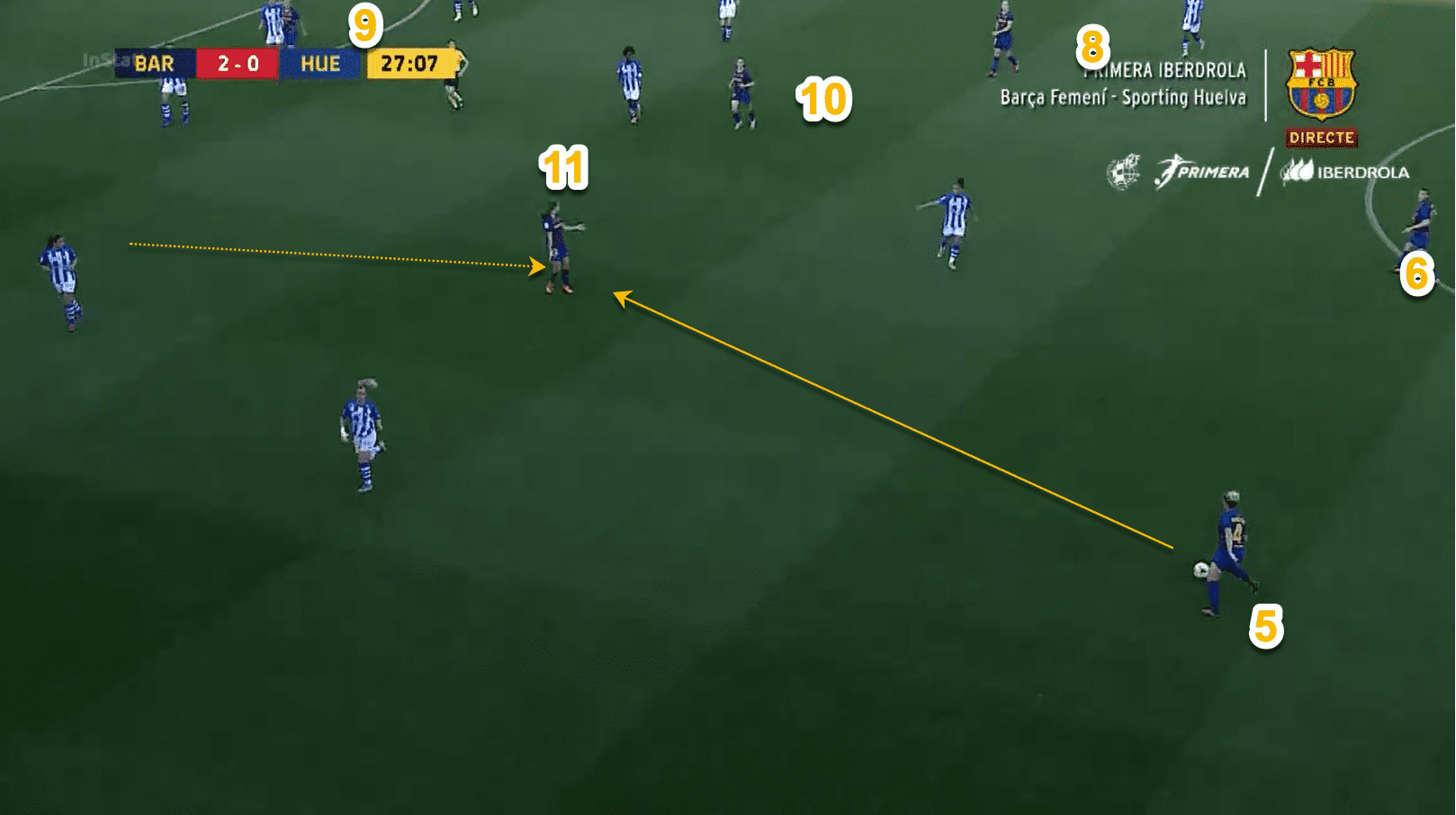
This is an example in which #11 Martens has rotated infield from the left forward position to create a central overload and has been able to find space between the oppositions defensive lines of pressure, receive the ball, turn and attack forward on the dribble, provoke pressure from the right defender of Sporting Clue de Huelva, before timing a pass into the overlapping left defender Ana-Maria Crnogorcevic.
Playing wide to attack central
Barcelona stretch the field wide and high. Width is provided by either the wide defenders or the wide forwards, with both generally looking to be an alternate line (IE the right defender/right forward and left defender/left forward not positioned in the same vertical channel). A specific tactic Barcelona use is passing the ball into the player positioned in the wide channel in order to move the oppositions defenders out of the central compact defensive shape. The aim of this is to then pass the ball back into the interior or central channels and exploit the space create between the horizontal lines.
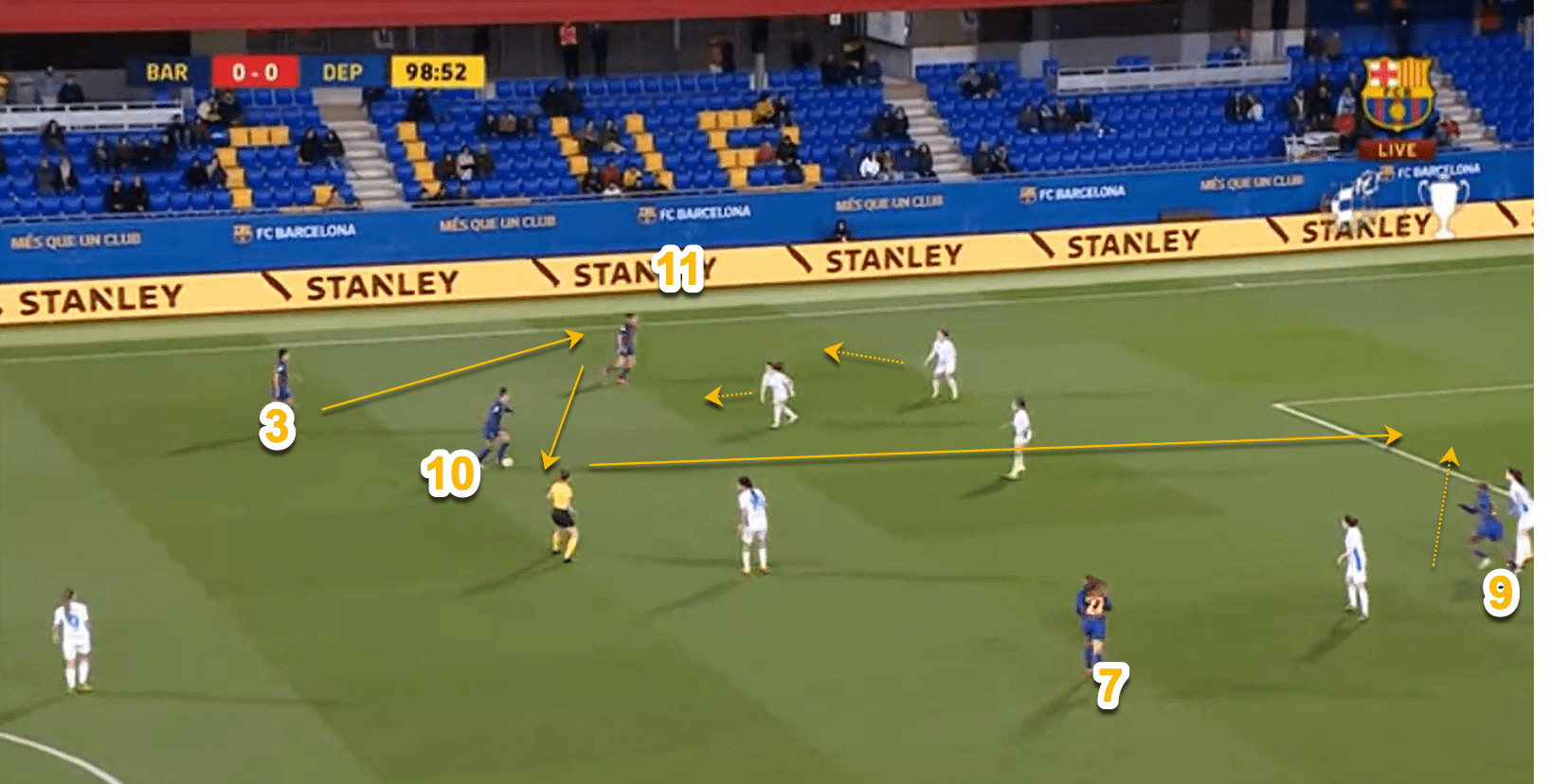
In the above example from Barcelona vs. Deportivo, the #11 Mariona Caldentey has received a pass in the left outside channel. For Deportivo to apply pressure, players have moved from being positioned centrally. By then playing a pass into the interior channel and to #10 Hermoso, a new vertical passing line into #9 Oshoala is open between the opponents right and central defenders.
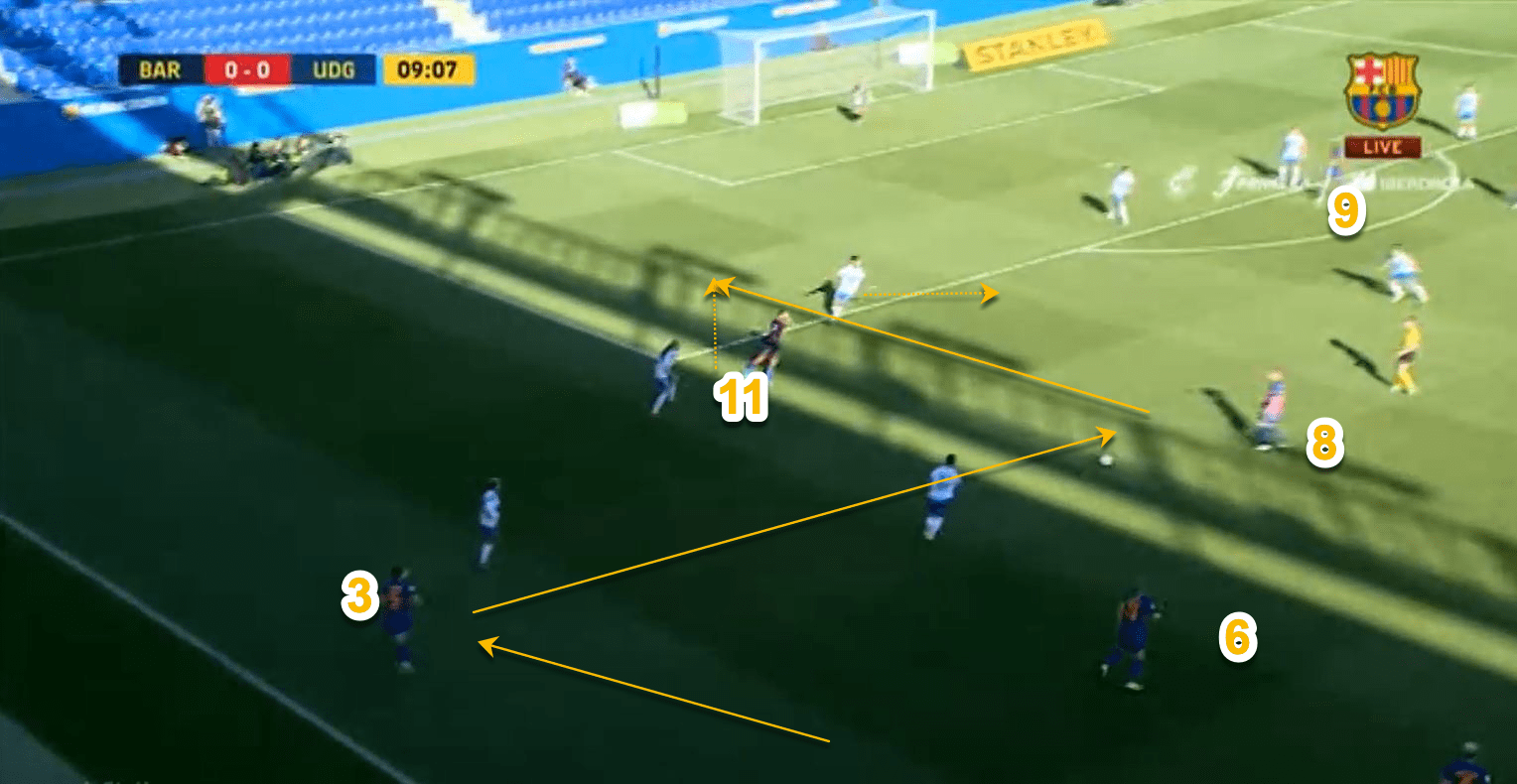
In the above example from Barcelona Vs. UD Grandilla Tenerife, #3 Melanie Serrano has received a pass into the left outside channel with #11 Martens making the underlapping run. As a result of the opposition pressuring Serrano and denying the pass into Martens, players have moved from the compact central positioning. This now opens a pass and a change of angle into the central midfield #8 Putellas who has a potential 2v1 and new passing line into Martens.
Conclusion
In conclusion to this tactical analysis of FC Barcelona Femeni when in possession and attacking vs. an organized opposition defense, the roles and responsibilities, specific patterns of play and attacking principles have been identified. These include wide combinations utilizing both overlapping and underlapping runs, positioning/receiving in the interior channel and passing wide to attack central. All these tactical approaches aim to move the opponent from an organized defensive structure into a disorganized defensive structure. This unbalancing of the opponent can then lead to Barcelona creating several high percentage scoring opportunities.

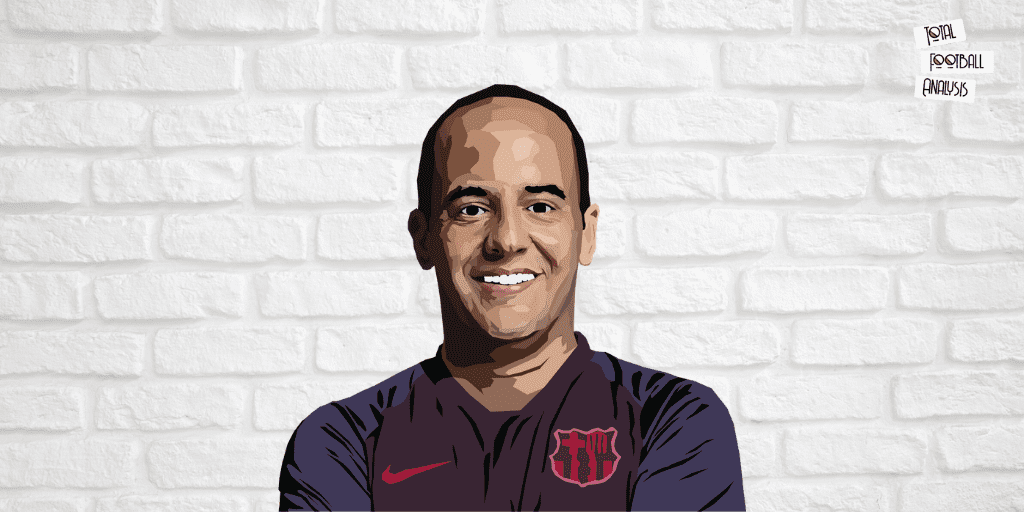



Comments